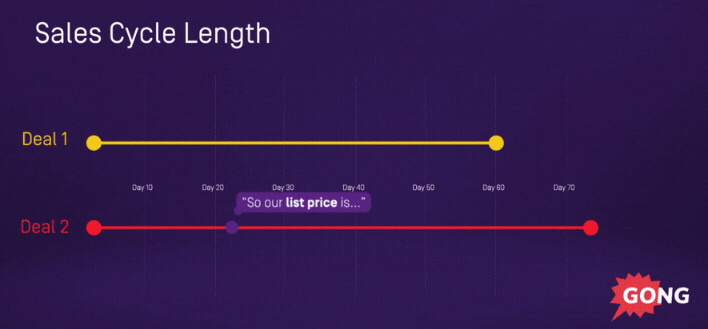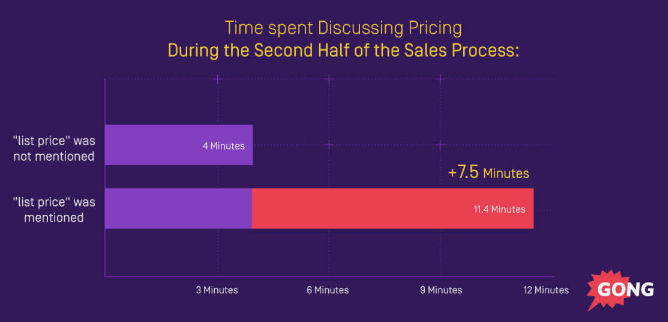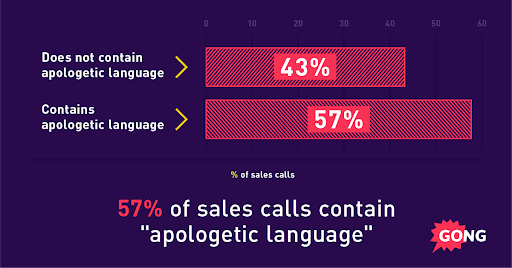The 11 negotiation skills every sales professional must master
If you are in sales, you know what the word negotiation means.
Heck, it’s always been — and still is — the #1 skill in sales.
The best-of-the-best salespeople are often the best-of-the-best negotiators. They know the negotiation techniques to win deals. They understand the art of making a deal. They are well-versed in the skills necessary to close.
And yet negotiation is often the most misunderstood skill in sales. Oh, and it’s hard to do it right. Gone are the used car salesman approach of “here’s an offer you just can’t refuse!
Here are 11 negotiation techniques and must-learn skills for sales pros.
P.S: Learn the high-stakes, do-or-die negotiation secrets from master negotiator Chris Voss. These 10 legendary techniques are how elite sellers skip the push back and close more deals.
Reductive negotiating tactic #1: do not negotiate over email (never ever ever do this)
Let’s just cut right to the chase on this negotiation skill.
Share pricing via email: OKAY.
Negotiate pricing via email: NOT OKAY.
Here’s why:
- Negotiating pricing over email introduces the (very real) risk of miscommunication. Email is essentially one-way communication. Too much can — and often does — get lost in an email (or text, for that matter). The phone is back-and-forth in real-time.
- Negotiating pricing over email gives your buyer an infinite amount of time to respond. This means you lose control of the conversation — never a good thing in sales.
- Negotiating pricing over email tends to drag out the sales cycle. Email sent. Email received. Email ignored. Email (eventually) read. Email (maybe) replied to. And so on…
- Negotiating pricing over email results in “lost power” behind a screen. It’s easy for a future customer to “hide” behind a device. It’s easy to ignore an email. Don’t give them that power!
- Negotiating pricing over an email makes it way (way!) easier to say no. Suffice to say, “no” is usually not a two-letter word any salesperson wants to hear.
Instead, assume your price negotiation conversation will happen over the phone: “I’d be more than happy to discuss pricing with you. How’s tomorrow at 4 PM PT?”
If they object, asking to just “discuss” via email, counter with, “I get that. Pricing can be a bit more nuanced, and I want to be sure what I share with you fits your budget and answers all of your questions. I’m sure we can knock this out in 7-9 minutes tops. Does tomorrow at 4 PM PT work?”
Lead the dance. Control the narrative. Navigate the conversation. Test out this skill during your next negotiation.
Reductive negotiating tactic #2: wait for the right time to discuss pricing
But when is the “right” time to discuss pricing? First call? Second call? After you’ve built rapport? Right out of the gate?
The Gong data team analyzed 11,331 opportunities when pricing and budget are first discussed in a sales cycle.
The result?
Win rates are 10% higher (!!) when pricing is discussed on the first call.

Note: To avoid bias, all the opportunities we analyzed included at least three calls.
Surprising, huh?
Even more surprising, the win rates remain the same whether the seller or the buyer mentions pricing first.
But when on that first call? 5 minutes in? 5 minutes from the end of the call?
The best of the best sales reps bring up the price in the 38-46-minute timeframe.

The key is you need some time (at least 38 minutes, on average) to build your value prop… and ideally, some rapport.
Be careful not to introduce pricing too soon… or too late.
Wait too long and run out of time to wrap up your call (it’s all about locking down next steps).
Get into pricing about 38 minutes into the first call.
Reductive negotiating tactic #3: switch from “we” to “I” during negotiations
Language matters. Words matter.
While the difference between “we” and “I” may seem subtle, it can make a world of difference during a sales negotiation.
We tends to be a bit formal while I introduces a more personal, comfortable, HUMAN tone — like a few people chatting over a beverage.
Said another way, We = a rep from my organization. I = I’m letting my guard down (or at least signalling that I am).
It’s imperative to humanize yourself during a negotiation… and the best of the best sellers know this. That’s why top sellers switch from “we” to “I” when they enter the negotiation phase of a deal.

It’s harder for a buyer to negotiate with a seller — a human (You! Their friend!), then battle with a big (non-human) company.
Pricing discussions with more “I” than “we” means your buyer is negotiating with you (good!) instead of a company (bad!).
Reductive negotiating tactic #4: say “approved pricing” (not “list pricing”)
One word can make a world of difference.
In fact, according to Gong data, sales cycles extend by 19% when the phrase “list price” OR “typical price” OR “standard price” is used at any point in a deal.

Moreso, if you utter the death phrase “list price” on either of your first two sales calls in a sales process, you will triple the time you spend discussing pricing later on:

Yikes!
Instead, try saying APPROVED PRICE
Swapping out “list” or “typical” or “standard” for APPROVED makes the buyer believe the price is more set in stone. Using “approved” signals someone higher up than you (Sales VP, VP of Finance/CFO) has set the pricing, already determining what’s possible and reasonable.
Bottom line: The approved pricing won’t change easily, so there is no need for your buyer to spend time negotiating.
PS: And if you think it’s only about saying the right words, you’re mistaken. Even sales proposals need to be couched in the right terms (or risk falling into a negotiation stalemate). Use this template to juice up your proposal in your next closing call – it’s free, for now.
Reductive negotiating tactic #5: don’t apologize for pricing (do this instead)
*Sales professionals apologize all the time! Apologizing for being late. Apologizing for “taking up valuable time.” Apologizing for our product and our pricing.
Apologies can be tricky (and common) — especially in the sales world.
First, should you apologize? (YES)
When do you apologize? (DURING PRICING NEGOTIATIONS)
What to not apologize for? (YOUR PRICING)
Yet apologies can be more nuanced than the above.
The data does not lie: 57% of sales calls contain ANY form of apologetic language: sorry, apologize, forgive, pardon.

The Gong data team looked at how and when (and when not) to apologize, but for the purposes of apologizing and negotiations…
Apologize during pricing negotiations, but NEVER apologize for your pricing.
Let’s break that down a bit.
To be blunt, we recommend you apologize during pricing negotiations.
If done correctly, an apology can be a negotiation tactic. You shift the “blame” on a price reduction request to you, the salesperson. You OWN the blame.
Here are a few examples of how an apology during a price negotiation may sound:
EXAMPLE #1: “I’m sorry. I want to offer you that number – and if it were up to me, I would. But that discount simply isn’t doable.”
EXAMPLE #2: “I apologize, I really want this to work, and this is so embarrassing, but I can only afford to pay you $20k.” — Chris Voss, when “buying” a red truck.
Can you spot the missing word from both examples? No.
The missing word is “no.”
It’s subtle yet intentional. You are not telling the buyer no. Instead, you are merely stating it’s not possible. Then, it’s time to move the conversation to what is possible. You and the prospect are not working together! You are on the same page in the same book.
Sidenote: Don’t apologize for your price. The price is the price is the price (is the price). It is what it is.
Reductive negotiating tactic #6: pause after you share price
“Our approved price* is $12,000 per year.”
*See #2 above
[ONE-SECOND PAUSE]
The silence is crushing you.
[ONE-SECOND PAUSE]
It’s now getting awkward.
[ONE-SECOND PAUSE]
Okay. You can now breathe again.
Pause for 3 painfully-long seconds after you introduce your pricing to your buyer.
It will feel like an eternity. You will be uncomfortable. You will get fidgety.
The “awkward pause” is the opposite of the human tendency to “fill the silence” in a conversation. But… this 3-second pause will allow your future customer to respond. If you resist the urge to talk for a few seconds longer than feels normal, you are more likely to allow your prospect to respond. And who knows, maybe their response will be, “WE ARE IN!”
See? Sales negotiations are easy — wink wink.
Note: This negotiation skill is consistent with the “talk less, listen more” (aka, strive to reduce your talk-ratio!) mantra.
Reductive negotiating tactic #7: use the f word
Fair.
According to Chris Voss, former FBI hostage negotiator, FAIR is the single-most powerful word in any negotiation.
Humans innately crave fairness. We want to be perceived as fair, and we want to receive what is fair. Unfair is… icky.
According to Gong Labs data, top performers use the word “fair” 1.7x per deal (i.e., all calls that span one deal), while everyone else uses it 0.2x.
In other words, use the word “fair,” but don’t overuse it.
Think of it as a way to ask a question, handle a possible objection, get buy-in, AND move a deal forward to the next step. Something like this:
“I’d love to step you through our product demo. It should take about 45 minutes max. All I ask is if it makes sense — if you are intrigued by what you learn — that we schedule a concrete next step at the end of the demo. Is that fair?”
One single word. Super-powerful. Easy-to-test skill!
Reductive negotiating tactic #8: mirroring
Sales is all about building rapport, making a human-to-human connection — ensuring your buyer is comfortable with you.
Sales is also about extracting information and avoiding confrontation.
And one of the best ways to pull out this valuable information, while avoiding conflict, (and get your prospect talking more) is to use the mirroring technique.
Simply put, mirroring is repeating back the one to three main words from one of your prospect’s statements. When doing this, use an “upward voice tone,” indicating you are asking a question.
Here is what it might sound like:
Buyer: “We have a hard time differentiating from our competitors. Our product is strong, but our reps tend to back peddle when customers ask how we’re different.”
You: Back peddle?
You “forced” your buyer to expand on their point WITHOUT saying, “Can you expand on that point?” <<– which sounds forced and awkward.
Having them repeat their own words eliminates friction. Bonus: It also means they are talking more… and you are talking less.
Reductive negotiating tactic #9: win over senior decision-makers (dms)
You’ve heard it a million times (because it’s true):
You gotta get to the DM.
Winning over senior decision-makers (DMs) during a sales negotiation is critical.
One such DM? The CFO.
Here is what Gong CFO, Tim Riitters, recently shared:
“The best way to get a deal done today is to prove how you’re going to help increase remote productivity, enhance visibility into their business, and/or increase agility. You have to come prepared to show how a specific investment will indeed save the company hard dollars. The bar for measurable and rapid Return on Investment is much higher than it was before.”
Additionally, Riitters says that CFOs are looking for visibility as they move to more of a remote workforce. Remote = more risk. And CFOs — especially CFOs — always try to mitigate risk, especially during uncertain times.
Finally, senior-level DMs are less interested in “nice to have” solutions. Sales folks must clearly demonstrate (but not lead with) ROI if you want to be taken seriously.
Reductive negotiating tactic #10: ask, “how am i supposed to do that?”
In this Chris Voss gem, he reminds us that “if you’re in a negotiation at all, you have leverage.”
And leverage is gained (and maintained) by giving the buyer the illusion of control.
Voss recommends asking a “How?” question to make a buyer feel more in charge. People love to answer “how” questions.
It also forces buyers to acknowledge the difficulty of what they are really asking from you.
The specific question to ask: “How am I supposed to do that?”
Voss continues, “The great thing about a properly constructed ‘How’ question is that it causes the person being asked it to stop and think about it on a number of levels, often causing them to take a look at you in a way that we call ‘forced empathy.’ They don’t even know what you are doing to them.”
“How am I supposed to do that” is one of the most powerful “how” questions. It’s a great way to say “no” without actually uttering that dreadful two-letter word!
Have your future customer walk you through what they are asking of you.
For example:
The buyer is asking for 3 free months and a 10% discount. You know there is absolutely no way you’ll get that past your sales manager.
Not. A. Chance.
BUT you can’t/don’t want to say no (see above).
Instead, you reply with, “How am I supposed to do that? How can I ask my boss to give you 3 months free AND a 10% discount?”
Try this negotiation skill during your next negotiation.
Reductive negotiating tactic #11: don’t ask for the close
Back in the day, it was all about the close.
Blake, played by (young) Alec Baldwin, famously uttered the phrase, “Always. Be. Closing.”
NEWSFLASH: Those days are over.
The hard close tactics (think: manipulation, pressure, and pushy tactics) no longer work. They tend to have the opposite effect.
Instead, lead your buyer toward the finish line and cross it with them.
The last few steps of any deal can be tricky. Your buyer may have emotional hurdles to overcome. They may raise a few last-minute concerns. They may go dark for a few hours/days.
Have no fear. You are their guide, their leader. Handle any final hiccups with calmness and ease. You’ve got this.
Lead. Close. Done.
Leadership is your new mantra. Be decisive. Make recommendations to help your buyer get from uncertainty to certainty.
Sign up to receive sales stats, data, and insights
How do top earners blow through finish-line pushback and grow their ACV (and commission)?
They demonstrate value.
Every step of the way.
This fill-in-the-blanks sales proposal template is your one-way ticket to building a bullet-proof business case and presenting where-do-I-sign sales proposals.
Use it to fast-forward through haggling and get your deal signed.


